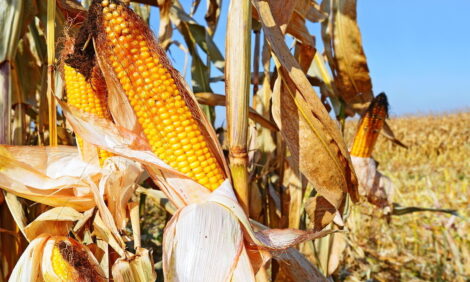



US Grains Council: Global Analysis of Grain Supply
GLOBAL - In its monthly agricultural supply and demand update, the US Department of Agriculture again lowered the outlook for US corn production, reflecting the continued deterioration of this year's crop due to the once-in-a-lifetime drought that affects most of the US Corn Belt.The latest USDA projection lowers US corn production to 274 million metric tons (10.8 billion bushels), down almost 40 million tons (1.6 billion bushels) from last year, and the lowest since 2006.
World corn production is estimated at 849 million tons (33.4 billion bushels), down 27 million tons (1.1 billion bushels) from last year, but 19 million tons (748 million bushels) higher than 2010/2011 due to higher production from China, Brazil and Argentina.

With this large reduction in US corn supplies, higher prices are expected to ration demand during the coming year. USDA projects that total world corn use will decline about 7 million tons (275.6 million bushels) from last year, while US total use will drop 25 million tons (984.2 million bushels):
- Feed use down 12 million tons (472.4 million bushels)
- Corn use for ethanol down 12.7 million tons (500 million bushels)
- Exports down 6.3 million tons (248 million bushels)
USDA expects world corn imports to decline by almost 7 million tons (275.6 million bushels), while non-US feed use will continue to grow, up 13 million tons (511.8 million bushels) from last year to 405 million tons (15.9 billion bushels).

Global Implications
From a broader perspective, world coarse grain feed use (including mainly corn, sorghum and barley) will be essentially unchanged from last year at 660 million tons, compared with 658.5 million tons in 2011/12.
Countries will respond to the tight corn supplies and higher prices in the coming year in different ways according the USDA estimate. For example, Japan and South Korea imports are projected to be unchanged from 2011 to 2012.
China's corn imports likely will decrease by 3 million tons (118.1 million bushels) due partly to a record domestic corn harvest of 200 million tons (7.9 billion bushels), which is up 7 million tons (275.6 million bushels) from last year.

Globally, all corn users will face the challenge of higher prices and the need for increased efficiency, careful risk management and creative marketing strategies during the coming year.
As the projections for US corn use demonstrate, the high prices will ration demand in all markets and in all sectors (feed, food and fuel). Also, the relatively smaller decline in US exports compared to domestic use reflects the resilience of global feed demand.
TheCattleSite News Desk


